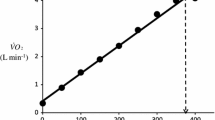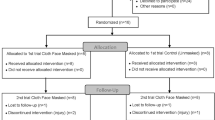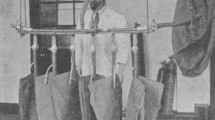Summary
It has been suggested that the mouthpiece-breathing valve assemblies commonly used in laboratory investigations of ventilatory control may influence regulation of arterial blood gas and acid-base status during exercise. To examine this hypothesis, 10 healthy males each underwent two incremental cycle-ergometer tests (15 W min−1) to the limit of tolerance: one was conducted free of breathing apparatus; the other utilized a mouthpiece (with noseclip) connected to a low-resistance turbine volume sensor. The order was randomly assigned and tests were separated by a 2 h recovery. Blood sampled from an indwelling brachial artery catheter at rest and every 30 W during exercise was analyzed for\(P_{{\text{CO}}_{\text{2}} } \),\(P_{{\text{O}}_{\text{2}} } \), pH and HCO3 −. Maximum power was not different between the two tests. Furthermore, no systematic effect of the assembly could be discerned on\(Pa_{{\text{CO}}_{\text{2}} } \),\(Pa_{{\text{O}}_{\text{2}} } \) or pHa over the entire range of power. We therefore conclude that although ventilation and its pattern may be affected by laboratory breathing apparatus, such encumbrance (if of low resistance and dead space) does not influence blood gas and acid-base regulation during exercise.
Similar content being viewed by others
References
Askanazi J, Silverberg PA, Foster RJ, Hyman AI, Milic-Emili J, Kinney JM (1980) Effects of respiratory apparatus on breathing pattern. J Appl Physiol 48:577–580
Beaver WL, Lamarra N, Wasserman K (1981) Breath-by-breath measurement of true alveolar gas exchange. J Appl Physiol 51:1662–1675
Beaver WL, Wasserman K, Whipp BJ (1986) Bicarbonate buffering of lactic acid generated during exercise. J Appl Physiol 60:472–478
Caiozzo VJ, Davis JA, Ellis JF, Azus JE, Vandagriff R, Prietto CA, McMaster WC (1982) A comparison of gas exchange indices used to detect the anaerobic theshold. J Appl Physiol 53:1184–1189
Cerretelli P, Sikand RS, Farhi LE (1969) Effect of increased airway resistance on ventilation and gas exchange during exercise. J Appl Physiol 27:597–600
Cole P, Forsyth R, Haight JSJ (1982) Respiratory resistance of the oral airway. Amer Rev Respir Dis 125:363–365
Dempsey JA, Vidruk EH, Mastenbrook SM (1980) Pulmonary control systems in exercise. Fed Proc 39:1498–1505
Douglas CG (1927) Coordination of the respiration and circulation with variations in bodily activity. Lancet, July 30th, p 213
Douglas NJ, White DP, Weil JV, Zwillich CW (1983) Effect of breathing route on ventilation and ventilatory drive. Respir Physiol 51:209–218
Gilbert R, Auchincloss JH, Brodsky J, Boden W (1972) Changes in tidal volume, frequency, and ventilation induced by their measurement. J Appl Physiol 33:252–254
Hirsch JA, Bishop B (1982) Human breathing patterns on mouth piece or face mask breathing during air, CO2 or low O2. J Appl Physiol 53:1281–1290
Holmgren A, Linderholm H (1958) Oxygen and carbon dioxide tensions of arterial blood during heavy and exhaustive exercise. Acta Physiol Scand 44:203–215
Niinimaa V, Cole P, Mintz S, Shephard RJ (1980) The switching point from nasal to oronasal breathing. Respir Physiol 42:61–71
Niinimaa V, Cole P, Mintz S, Shephard RJ (1981) Oronasal distribution of respiratory airflow. Respir Physiol 43:69–75
Nunn JF, Campbell EJM, Peckett BW (1956) Anatomical subdivisions of the volume of the respiratory dead space and effect of position of the jaw. J Appl Physiol 14:174–176
Proctor DF (1977) The upper airways. I. Nasal physiology and defense of the lungs. Am Rev Respir Dis 115:97–129
Reinhard U, Muller PH, Schmulling RM (1979) Determination of anaerobic threshold by ventilation equivalents in normal individuals. Respiration 38:36–42
Rodenstein DO, Mercenier C, Stanescu DC (1985) Influence of the respiratory route on the breathing pattern in humans. Amer Rev Respir Dis 131:163–166
Rowell LB, Taylor HL, Wang Y, Carlson WB (1964) Saturation of arterial blood with oxygen during maximal exercise. J Appl Physiol 19:284–286
Sackner JD, Nixon AJ, Davis B, Atkins N, Sackner MA (1980) Effects of breathing through external dead space on ventilation at rest and during exercise. II. Am Rev Resp Dis 122:933–940
Seldinger SI (1953) Catheter replacement of needle in percutaneous arteriography: a new technique. Acta Radiol (Stockh) 39:368–376
Ward SA, Whipp BJ (1980) Ventilatory control during exercise with increased external dead space. J Appl Physiol 48:225–231
Wasserman K, VanKessel AL, Burton GG (1967) Interaction of physiological mechanisms during exercise. J Appl Physiol 22:71–85
Wasserman K, Whipp BJ (1975) Exercise physiology in health and disease. Am Rev Respir Dis 112:219–249
Wasserman K, Whipp BJ, Casaburi R, Beaver WL, Brown HV (1977) CO2 flow to the lungs and ventilatory control. In: Dempsey JA, Reed CE (eds) Muscular Exercise and the Lung. Univ Wis Press, Madison, pp 103–135
Whipp BJ (1981) The control of exercise hyperpnea. In: Hornbein T (ed) The Regulation of Breathing. Dekker, New York, pp 1069–1139
Whipp BJ, Mahler M (1980) Dynamics of pulmonary gas exchange during exercise. In: West JB (ed) Pulmonary Gas Exchange, vol II. Academic Press, New York, pp 33–96
Zechman F, Hall FG, Hull WE (1957) Effects of graded resistance to tracheal airflow in man. J Appl Physiol 10:356–362
Author information
Authors and Affiliations
Additional information
Supported by National Institutes of Health grant# HL 11907
Senior Investigator of the American Heart Association (Greater Los Angeles Affiliate)
Rights and permissions
About this article
Cite this article
Ward, S.A., Wasserman, K., Davis, J.A. et al. Breathing-valve encumbrance and arterial blood gas and acid-base status in exercise in man. Europ. J. Appl. Physiol. 58, 382–388 (1989). https://doi.org/10.1007/BF00643513
Accepted:
Issue Date:
DOI: https://doi.org/10.1007/BF00643513




